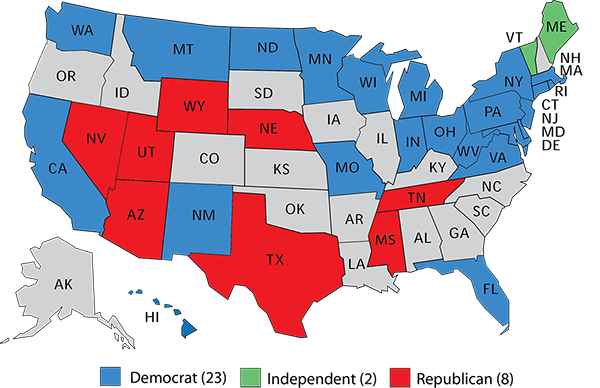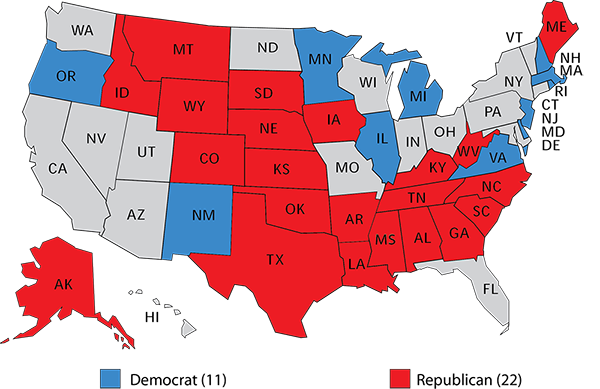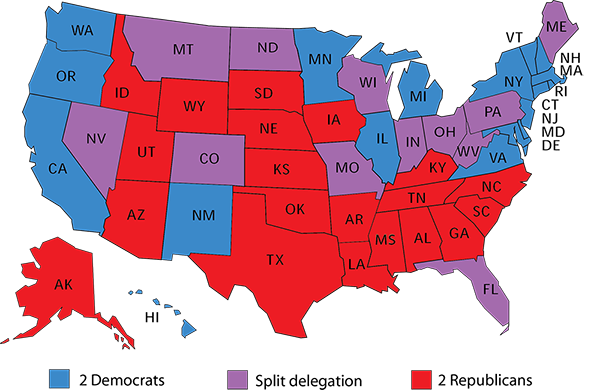The Republican Senate Edge
A Commentary By Kyle Kondik
A look at all three classes shows the difficulties for Democrats in winning a majority in a polarized era
The U.S. Senate is a curious, unique legislative body for a lot of reasons. It has arcane rules, such as the filibuster, which limits the passage of most legislative items unless 60 members vote yes. Representation in the Senate is not based on population; instead, each state gets two and only two senators, meaning that California (the most populous state) and Wyoming (the least populous) have equal say in the Senate. Each get 2% of the Senate’s membership — two out of 100 senators — even though California has 12% of the nation’s people while Wyoming only has 0.2%. And unlike the House, where the entire membership is on the ballot every two years, only a third of the Senate’s membership is on the ballot each federal election cycle.
A telling sign of the Democratic Party’s challenge in the next Senate election is that slightly more than half of the party’s current caucus, 25 of the 48 members,[1] are on the ballot next year. So even though only a third of the nation’s 100 Senate seats are regularly scheduled for election every two years, a majority of the entire Democratic caucus has to run next year.
Meanwhile, just eight of the 52 Senate Republicans will be on the ballot next year, or 15% of the GOP caucus.[2] So the current party control of 2018’s Senate Class I is 25-8 Democratic.
Map 1: Current party control of Senate Class I, up for election in 2018
Democrats have managed to net seats on this map in each of the last three elections, adding four in 2000, an additional six to flip control of the upper chamber in 2006, and then two more in 2012 when most expected them to lose net seats because of the sheer volume of ground they were defending. The last good Republican performance in Class I’s elections was 1994, when the GOP netted eight seats and flipped the Senate. When a party does as well on a Senate map as the Democrats have on this one over several cycles, they eventually crash, although the rhythms of midterm elections and the president’s poor approval rating could put off that crash for at least another six years. Or not.
We’ve written extensively about next year’s Senate elections already, and we don’t want to cover the same ground here. Whatever does happen next year, though, Republicans have much more ground to defend over the next two Senate elections, but they are not as vulnerable as they may seem at first blush.
Given the imbalance of Senate Class I, it’s not a shock that Senate Classes II and III, which will next be on the ballot, are imbalanced as well, but instead in favor of the Republicans. Let’s look at them in order.
Senate Class II, last on the ballot in 2014 and up again in 2020’s presidential election, features 22 Republicans and 11 Democrats.
Map 2: Current party control of Senate Class II, up for election in 2020
This map has flipped twice in the last two election, first cementing and then dismantling a Democratic Senate majority. Republicans netted two seats apiece in 1996 and 2002 to build a 21-12 edge in Class II, a precarious advantage that flipped to 20-13 Democratic as they picked up eight seats amidst Barack Obama’s first presidential victory in 2008. That turned a slim 51-49 Democratic Senate majority into a 59-41 advantage that grew to 60-40 with Pennsylvania Sen. Arlen Specter’s party switch, although the contested election of Sen. Al Franken (D-MN), who wasn’t seated until July 2009, followed by the death of Sen. Ted Kennedy (D-MA) and Scott Brown’s (R) subsequent upset victory in the special election to replace Kennedy in early 2010 limited the Democrats’ filibuster-proof majority to just several months.
Democrats held the Senate in the 2010 and 2012 elections, but their nine-seat net loss on 2014’s Class II map led to the GOP taking a 54-46 majority starting in 2015, a majority they continue to hold (albeit two seats weaker after 2016) now.
One would expect that Democrats would have more targets than Republicans in 2020, and that is correct, although the size of the Republican gain in 2014 perhaps makes their 2020 defenses seem harder than they might actually be.
In flipping the Senate in 2014, Republicans beat Democrats in several states that are very Republican at the presidential level. So while first-term Republicans dot the map, they represent some deep red territory that even a weakened President Trump running for reelection, or another Republican candidate, should be able to carry comfortably in the presidential election: Alaska, Arkansas, Louisiana, Montana, South Dakota, and West Virginia. Whoever wins the December special election in Alabama — probably lightning rod Republican Roy Moore — will also be back on the ballot in this election. With a different occupant in the White House than Barack Obama, perhaps Democrats can field credible challengers in these states, but none of these states are trending Democratic.
Still, Republicans may have a harder time defending states like Iowa and North Carolina, and two of the three Republicans in states carried by Hillary Clinton are up for reelection as well: Sens. Susan Collins of Maine and Cory Gardner of Colorado. Collins is typically untouchable, but she may run for governor next year or retire in 2020, and while Gardner is a strong incumbent who arguably ran the best GOP campaign in 2014, Colorado is a very competitive state that has moved slightly left of the national average.
Meanwhile, most of the 11 Democrats up for reelection seem very safe, although Republicans could credibly target incumbents in presidential swing states Michigan, Minnesota, New Hampshire, and Virginia.
Add it all up, and Democrats might be favored to make a modest net gain on this Senate map to start the 2020 cycle, but the Republicans do not start with a glaring handicap even though they already control two-thirds of the seats being contested. One other thing about Class II: Just by chance, its 33 senators represent only about half of the nation’s population, while the other two feature senators who represent around three-quarters apiece. The reason is that Class II does not include five of the seven most populous states: California (1st in population), Florida (3rd), New York (4th), Pennsylvania (6th), and Ohio (7th).
Moving to 2022, the Republicans again will be playing more defense than offense in all likelihood because they already hold a 22-12 edge in Senate Class III.
Map 3: Current control of Senate Class III, up for election in 2022
Since Democrats used Class III to net eight seats and recapture the Senate in 1986, Republicans gradually built a big lead on this map. After zero net change in both 1992 and 1998, Republicans gained four seats in Class III in 2004 and then six as part of the 2010 wave, a gain that arguably should have been bigger if not for the nomination of weak GOP candidates in Colorado, Delaware, and Nevada that year.
Democrats hoped to ride anti-Trump coattails to a Senate majority on this map last year, but their gains were confined to just Illinois and New Hampshire, where Democratic Senate candidates (and Hillary Clinton) chalked up wins. And, because 2016 was the first election ever where each state with a Senate election supported the same party for president and for Senate, at this point neither party has to defend a Senate seat in 2022 won by the other party at the presidential level. However, that could easily change after the 2020 presidential election: No two consecutive presidential elections have ever featured the exact same Electoral College map, though many have been quite similar (a recent example: Barack Obama only lost two states, Indiana and North Carolina, from his 2008 map in 2012). Still, one would expect at least one or more states to switch their presidential allegiance one way or the other in 2020.
The next election of Senate Class III might as well be a political generation away — we have another presidential election before then, and as we’ve noted many times before, whichever party holds the White House has to fight through a typical midterm penalty — but it stands to reason that some of the states that were very competitive in 2016 would be again in 2022’s midterm election. Democrats likely would have to put resources into defending Colorado, Nevada, and New Hampshire, while Republicans would have a longer list of potentially vulnerable states: Florida, North Carolina, Ohio, Pennsylvania, and Wisconsin (Sen. Ron Johnson has already indicated he will not run for a third term) are all possibilities, and other seats may become competitive if some long-serving senators do not run for new terms, like Arizona’s John McCain (who currently is fighting a very serious form of brain cancer) as well as other senior members like Georgia’s Johnny Isakson and Iowa’s Chuck Grassley. Again, one could probably say the same thing about 2022 as one could say about 2020: Republicans would be overextended but Democrats wouldn’t be guaranteed anything.
Which brings us to one final map, and one final, important point:
Conclusion: The Republicans’ overarching Senate edge
Much has been made of the fact that next year Senate Democrats are defending 10 seats in states Trump won in the presidential race, while Senate Republicans are defending only one seat in a Clinton-won state, held by Sen. Dean Heller (R-NV). These represent the vast majority of the 14 total “crossover” seats in the Senate, those held by a party different than the one that captured the state in the 2016 presidential race. The other three crossover-state senators are Sen. Gary Peters (D-MI), a Democrat in a Trump state up for reelection in 2020, and the aforementioned Gardner of Colorado and Collins of Maine, also up for reelection in 2020. So Republicans hold a 52-48 advantage right now despite holding only three seats in Clinton-won states, while Democrats have 11 Trump-state seats and are still in the minority.
That speaks to the GOP advantage in the Senate right now. Even though Trump lost the popular vote by two percentage points, he won 30 states in the Electoral College, while Clinton won only 20. Because all states are created equal in the Senate, the median state in the Electoral College gives us a sense of the GOP tilt of the states overall. In ranking all the states by presidential margin from most to least Republican, the median falls between Arizona and North Carolina, which Trump won by an average of about 3.6 points, so presidential performance in the median Senate seat is roughly 5.5 points to the right of the nation. That’s about the same Republican lean of the median House seat by presidential performance, the Hampton Roads-based seat held by Rep. Scott Taylor (R, VA-2).
Map 4 shows the Senate delegations from all 50 states, with each state shaded by whether they are represented by two Democrats, two Republicans, or a split.
Map 4: Current party control of Senate
Note: For the purposes of this map, Sens. Angus King (I-ME) and Bernie Sanders (I-VT) are categorized as Democrats because they are part of the Democratic caucus even though they are independents.
As is clear, Democrats hold several seats in states where one might think, based on the presidential results, they have no business holding Senate seats in a polarized era. All of those dark-red state Democratic senators are up for reelection next year.
If a significant number of them lose to Republicans, it’s hard to see how Democrats could make up that ground in 2020 or 2022 based on the seats being contested. Such is the GOP advantage, and the Democratic handicap, in the three Senate classes.
Footnotes
1. Independent Sens. Angus King of Maine and Bernie Sanders of Vermont, both of whom are running for reelection next year, are members of the Democratic caucus and thus are counted as such here.
2. This does not include the special Senate election in Alabama, which will be held in December.
Kyle Kondik is a Political Analyst at the Center for Politics at the University of Virginia.
See Other Political Commentary by Kyle Kondik.
See Other Political Commentary.
Rasmussen Reports is a media company specializing in the collection, publication and distribution of public opinion information.
We conduct public opinion polls on a variety of topics to inform our audience on events in the news and other topics of interest. To ensure editorial control and independence, we pay for the polls ourselves and generate revenue through the sale of subscriptions, sponsorships, and advertising. Nightly polling on politics, business and lifestyle topics provides the content to update the Rasmussen Reports web site many times each day. If it's in the news, it's in our polls. Additionally, the data drives a daily update newsletter and various media outlets across the country.
Some information, including the Rasmussen Reports daily Presidential Tracking Poll and commentaries are available for free to the general public. Subscriptions are available for $4.95 a month or 34.95 a year that provide subscribers with exclusive access to more than 20 stories per week on upcoming elections, consumer confidence, and issues that affect us all. For those who are really into the numbers, Platinum Members can review demographic crosstabs and a full history of our data.
To learn more about our methodology, click here.




